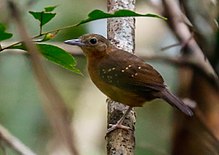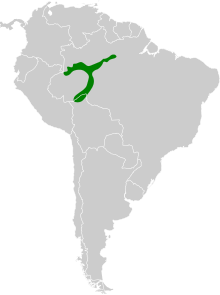Humaita antbird
| Humaita antbird | |
|---|---|

| |
| Male at Careiro, Amazonas state, Brazil | |

| |
| Female at Careiro, Amazonas state, Brazil | |
| Scientific classification | |
| Domain: | Eukaryota |
| Kingdom: | Animalia |
| Phylum: | Chordata |
| Class: | Aves |
| Order: | Passeriformes |
| Family: | Thamnophilidae |
| Genus: | Myrmelastes |
| Species: | M. humaythae
|
| Binomial name | |
| Myrmelastes humaythae (Hellmayr, 1907)
| |

| |
| Synonyms | |
| |
The Humaita antbird (Myrmelastes humaythae) is a species of passerine bird in subfamily Thamnophilinae of family Thamnophilidae, the "typical antbirds".[2] It is found in Brazil, Bolivia, and Peru.[3]
Taxonomy and systematics
[edit]The Humaita antbird has a complicated taxonomic history. It was described by Carl Eduard Hellmayr as Sclateria schistacea humaythae, a subspecies of the slate-colored antbird (now M. schistaceus).[4] Later authors placed it as a subspecies of the spot-winged antbird (now M. leucostigma), which was successively placed in genera Percnostola and Schistocichla.[5] A 2007 study of the vocal characteristics of the then many subspecies of the spot-winged found significant differences between the taxa. Based on this evidence the Humaita antbird was promoted to species status and given its English name.[6][7] A 2013 study finalized its move to genus Myrmelastes.[8]
The Humaita antbird is monotypic.[2]
Description
[edit]The Humaita antbird is 14 to 16 cm (5.5 to 6.3 in) long. Males have medium gray upperparts with an olive-brown tinge. Their wings and tail are blackish gray with wide white tips on the wing coverts. Their throat and underparts are paler gray. Females have a brown crown and upperparts. Their wings and tail are blackish brown with pale cinnamon-rufous tips on the wing coverts. Their face is gray. Their throat and belly are pale tawny and their flanks and undertail coverts olive-brown. Both sexes have pink legs and feet.[9][10][11]
Distribution and habitat
[edit]The Humaita antbird is found in western Amazonian Brazil, the eastern part of the Department of Madre de Dios in southeastern Peru, and in Pando Department in far northern Bolivia. In Brazil it occurs north of the Amazon between the lower Japurá and lower Negro rivers and south of the Amazon east to the Madeira River.[9][12] It primarily inhabits the floor and understorey of terra firem evergreen forest. Within the forest it favors poorly drained areas and areas along small watercourses.[9][10][11]
Behavior
[edit]Movement
[edit]The Humaita antbird is believed to be a year-round resident throughout its range.[9]
Feeding
[edit]The Humaita antbird's diet and foraging behavior are not known but are assumed to be very similar or identical to those of its former "parent" the spot-winged antbird, which see here.[9]
Breeding
[edit]Nothing is known about the Humaita antbird's breeding biology.[9]
Vocalization
[edit]The Humaita antbird's song is a long trill that rises in pitch from start to finish and whose pace increases at the beginning, is steady in the middle, and decreases towards the end.[9] The species' calls apparently are the same as those of the spot-winged antbird, which include a "long, downslurred, typically frequency-modulated whistle", an "abrupt unclear note given singly or in series of 2–5", and a "short rattle".[9][13]
Status
[edit]The IUCN has assessed the Humaita antbird as being of Least Concern. It has a large range; its population size is not known and is believed to be stable. No immediate threats have been identified.[1] It is considered uncommon in most of its range. It occurs in Brazil's Humaitá Reserve, and its range also includes "extensive areas of intact habitat which are not formally protected, but seem unlikely to be threatened by development in the near future".[9]
References
[edit]- ^ a b BirdLife International (2016). "Humaita Antbird Myrmelastes humaythae". IUCN Red List of Threatened Species. 2016: e.T22736158A95125459. doi:10.2305/IUCN.UK.2016-3.RLTS.T22736158A95125459.en. Retrieved 29 July 2024.
- ^ a b Gill, Frank; Donsker, David; Rasmussen, Pamela, eds. (January 2024). "Antbirds". IOC World Bird List. v 14.1. Retrieved 4 January 2024.
- ^ Remsen, J. V., Jr., J. I. Areta, E. Bonaccorso, S. Claramunt, G. Del-Rio, A. Jaramillo, D. F. Lane, M. B. Robbins, F. G. Stiles, and K. J. Zimmer. Version 27 July 2024. Species Lists of Birds for South American Countries and Territories. https://www.museum.lsu.edu/~Remsen/SACCCountryLists.htm retrieved July 28, 2024
- ^ Hellmayr, Carl Eduard (2007). "Sclateria schistacea humaythae, subsp. n." Bulletin of the British Ornithologists' Club. XIX (CXXVII): 50–51. Retrieved July 29, 2024.
- ^ Remsen, J. V., Jr., J. I. Areta, E. Bonaccorso, S. Claramunt, G. Del-Rio, A. Jaramillo, D. F. Lane, M. B. Robbins, F. G. Stiles, and K. J. Zimmer. Version 27 July 2024. A classification of the bird species of South America. American Ornithological Society. https://www.museum.lsu.edu/~Remsen/SACCBaseline.htm retrieved July 28, 2024
- ^ Isler, M.L.; Isler, P.R.; Whitney, B.M.; Zimmer, K.J. (2007). "Species limits in the "Schistocichla" complex of Percnostola antbirds (Passeriformes: Thamnophilidae)". Wilson Journal of Ornithology. 119 (1): 53–70. doi:10.1676/05-121.1. S2CID 84340283.
- ^ "Proposal (301): Elevate subspecies humaythae, brunneiceps, and rufifacies (within Schistocichla leucostigma) to species rank". South American Classification Committee of the American Ornithological Society. 2006. Retrieved July 29, 2024.
- ^ Isler, M.L., Bravo, G.A. and Brumfield, R.T. (2013). Taxonomic revision of Myrmeciza (Aves: Passeriformes: Thamnophilidae) into 12 genera based on phylogenetic, morphological, behavioral, and ecological data. Zootaxa 3717(4): 469–497.
- ^ a b c d e f g h i del Hoyo, J., N. Collar, and G. M. Kirwan (2020). Humaita Antbird (Myrmelastes humaythae), version 1.0. In Birds of the World (J. del Hoyo, A. Elliott, J. Sargatal, D. A. Christie, and E. de Juana, Editors). Cornell Lab of Ornithology, Ithaca, NY, USA. https://doi.org/10.2173/bow.humant1.01 retrieved July 29, 2024
- ^ a b van Perlo, Ber (2009). A Field Guide to the Birds of Brazil. New York: Oxford University Press. pp. 256–257. ISBN 978-0-19-530155-7.
- ^ a b Schulenberg, T.S., D.F. Stotz, D.F. Lane, J.P. O’Neill, and T.A. Parker III. 2010. Birds of Peru. Revised and updated edition. Princeton University Press, Princeton, New Jersey. Plate 171.
- ^ Clements, J. F., P.C. Rasmussen, T. S. Schulenberg, M. J. Iliff, T. A. Fredericks, J. A. Gerbracht, D. Lepage, A. Spencer, S. M. Billerman, B. L. Sullivan, and C. L. Wood. 2023. The eBird/Clements checklist of birds of the world: v2023. Downloaded from https://www.birds.cornell.edu/clementschecklist/download/ retrieved October 28, 2023
- ^ Zimmer, K., M.L. Isler, and G. M. Kirwan (2020). Spot-winged Antbird (Myrmelastes leucostigma), version 1.0. In Birds of the World (J. del Hoyo, A. Elliott, J. Sargatal, D. A. Christie, and E. de Juana, Editors). Cornell Lab of Ornithology, Ithaca, NY, USA. https://doi.org/10.2173/bow.spwant3.01 retrieved July 29, 2024


